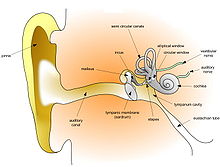Physical acoustics
Physical acoustics deals with the physical principles of acoustics , which are based on vibrations.
Physical acoustics is about the longitudinal waves , the sound waves that are perceived by the ear. The ear as a sound receiver reacts to sound waves with frequencies between 20 Hz and 20,000 Hz; sound waves of higher frequencies are assigned to ultrasound . Sound waves represent a spreading sequence of air compression and thinning. The individual air particles vibrate only within small areas. A sound wave does not transport matter. In the case of sound vibrations, a distinction is made between tone, sound, noise and bang, whereby a pure tone can be represented with a sine curve . When it bangs, the oscillation has a large, rapidly decaying amplitude.
Sounder
Sounders are plates and membranes. They are used to generate sound, for example in telephones and loudspeakers. Vibrating strings are also linear sounders. You can excite the air to vibrate along a line, but the vibrations emanating from the front and back of the string are almost canceled out by interference. With musical instruments, strings are therefore stretched on a wooden case in order to amplify the resonance, with certain dimensions the wooden case acts as a resonance body. With string instruments it is important that the natural frequency is amplified by the soundboard of the instrument.
The following equation applies to vibrating strings:
Here, the length of the string, the frequency of the vibrating string, the force with which the string is tensioned, the density of the string material and the cross-section of the string.
scale
In music there is the scale, which consists of the eight tones cdefgahc, with two tones each having a certain frequency ratio: prime, second, third, fourth, fifth, sixth, seventh, octave ( interval ). The 12 semitone intervals do not have a uniform frequency ratio. For the physical tuning one starts with the dashed C and sets ν (c ') = 256 Hz, for the international tuning the concert pitch a' with ν (a ') = 440 Hz applies .
Sound receiver
Sound receivers are instruments that react to pressure fluctuations in a sound wave, such as the ear. Also microphones are sound receiver. Pressure fluctuations cause a membrane to vibrate. These are converted into electrical current fluctuations that can be detected with a suitable instrument.
Humans perceive tones as consonance (melodious) when the frequency relationships cannot be expressed by whole numbers greater than eight, otherwise as dissonance .
The ear
The sensation that the ear perceives from a pure sinusoidal oscillation of the air is called a physically simple or pure sound. The pitch depends on the frequency . The higher the frequency, the higher the tone. The volume depends on the amplitude of the sinusoidal oscillation. The larger the amplitude, the louder the sound. The sensation that the ear has of a periodic but not sinusoidal oscillation is called sound. This creates frequencies of harmonic harmonics or overtones in an integer ratio to the fundamental (fundamental). Ohm's law of acoustics applies to the lamentation of the ear : the sound only depends on the frequencies and amplitudes, but not on the phase differences.
Resonance as the basis of acoustics
Resonance phenomena can occur in all coupled vibration systems. If the frequency ω is equal to the natural frequency of the oscillator , the oscillation has a maximum at that point. There is a response . The natural frequency of a system is therefore called the resonance frequency. With weak damping, the resonance curve is narrow, one speaks of a sharp resonance, for strong damping the resonance curve is correspondingly wide. If a glass is struck, it produces a tone in the natural frequency of the glass, which can be heard for a longer or shorter period depending on the attenuation. A glass with little damping can shatter due to an intense sound wave at a frequency that is very close to the natural frequency of the glass due to the resonance vibrations that occur.
In acoustics, too, the same vibration equation applies to pure tones - without taking damping into account - as for the harmonic oscillator :
- ,
where ω is the resonance frequency, φ is the phase shift and u is the amplitude.
interference
- The same principles apply to the superposition of sound waves as to other types of waves .
- The superposition of two sound waves in the same direction of propagation results in a beat with a small frequency difference .
- The amplitude of the resulting wave periodically decreases and increases.
Sound intensity
- The minimum strength that a sound must have in order to be perceived is the hearing threshold , the upper limit is the pain threshold .
- The sound level is the 10-fold decadic logarithm of two sound levels . The unit is decibel .
- The volume with which a person subjectively perceives a sound strength depends on the sense of hearing and is a physiological quantity with the unit phon .
Ultrasonic
Frequencies above the audible range are called ultrasound.
literature
- H. Kuchling: Taschenbuch der Physik , Harry Deutsch Verlag (1986), 314–339, ISBN 3-87144-097-3 .
Individual evidence
- ^ Lothar Meyer, Gerd-Dietrich Schmidt: Physics. Duden Paetec GmbH Berlin, 2005, ISBN 3-89818-011-5 , p. 125
- ↑ Manfred Bormann: Experimental Physics. Volume 1 / b: Mechanics of deformable media, mechanical vibrations and waves, thermodynamics. Study publisher Dr. Brokmeyer, Bochum 1984, ISBN 3-88339-123-9 , pp. 133-120
- ^ Paul A. Tipler , Gene Mosca: Physics for Scientists and Engineers. Elsevier, Spektrum Akademischer Verlag, 2004, ISBN 3-8274-1164-5 , pp. 452-454.











